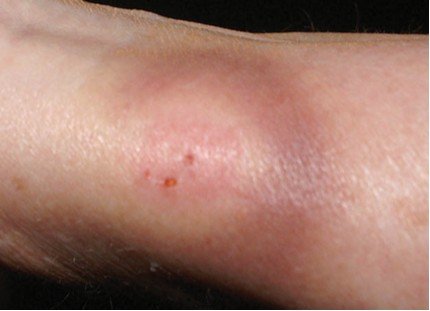Achilles tendinopathy or neurogenic pain ? A patient interview and initial clinical examination to clarify ! By Rolf Walter
The following story is rather unusual but I thought it was a nice one to share !
A 60 year old lawyer and former patient in my praxis, in good general condition, joins me in my praxis to ask for my opinion since he has been diagnosed with an Achilles tendinopathy and the referring general practioner has recommended a series of schok wave therapy at a medical specialist praxis. The lawyer wants to know if the prescription is appropriate, he apparently has some doubts !
The patient suffers intermittent foot and heel pain since two years after a walk on a sunny summer’s day through tall grass and shrubs with shorts. After this walk he notices blood coming out of two tiny holes of his calf as his something had bitten him.
In the begining he feels a burning pain and after a couple of hours his calf is swollen and has a skin rash for several hours. The lawyer goes to see his family Dr. and he ends up with the diagnosis that he suffered a tick bite.
In the direct period after he develops intense, excruciating pain on the lateral side of the foot towards the toes wich becomes sometimes so strong that even light touch hurts.
the weight of the bed sheet on his foot hurts; technically “allodynia”.
This excruciating pain lasts for about about 3-4 months and than slowly subsides over a period of several months.
During the painful episode his family Dr. sends the patient to a neurologist who excludes the presence of a tick bite. Blood tests show no borreliosis disease.
The neurologist does not prescribe other diagnostic tests since it would not have made any difference in the therapeutic follow-up of the clinical case.
The patient has no symptoms which would fit with a typical tendon problem, nor in localisation nor in behaviour of symptoms. Also the history of over two years of pain seems not consistent with a tendon pathology. The patient is not involved in overuse activities and has taken up some low level activity in the gym since about 1⁄2 a year but all without pain.
The actual symptoms are shoe related (more elegant, stiff and narrow shoes elicit pain in the lateral part of the foot towards and including the toes as well as in the heel. Sometimes he suffers sudden, spontaneous and shooting brief moments of symptoms in the foot and ankle.
Obviously a tick bite doesn’t leave two holes with blood dripping out of the tiny wounds and the tick normally remains attacked untill filled with the victim’s blood before dropping of spontaneously or is detected by the victim and has to be carefully removed
The cardinal symptom of Achilles tendinopathy is pain. Generally it occurs at the beginning and end of a training session, with a period of diminished discomfort in between. As the pathological process progresses, pain may occur during exercise, and, in severe cases, it can interfere with activities of daily living. In the acute phase, the tendon is diffusely swollen and oedematous, and on palpation tenderness is usually greatest 2–6 cm proximal to the tendon insertion. Sometimes, fibrin precipitated from the fibrinogen-rich fluid around the tendon can result in palpable crepitation. In chronic cases, exercise-induced pain is still the cardinal symptom, while crepitations and effusions diminish. A tender, nodular swelling is usually present in chronic cases and is believed to signify tendinosis. Maffulli N. et al, JRSM 2004
On physical examination the patient has no local swelling in the distal tendon alltough the tendon is very painful at the pinch test but actually the whole distal calf and shin are hyperalgic on light scratch with my nail and elicits pain and pins and needle sensations in remote area’s towards the ankle and the lateral part of the foot and digit 4/5. Comparing to the left side there is also pain on the pinch test of the Achilles tendon but significantly less and light nail scratch over the lower part of the leg does not elecit any abnormal sensation. Neurological examination of muscle force and reflexes are normal, the patient has no history of lumbar problems.
Particular pain and remote symptoms are also elicited driving his car and using the right foot for accelleration as well as putting ND (neurodynamic stress) with bias towards distal lateral nerves of the foot and ankle (Sural nerve especially and superficial Peroneal nerve)
In summary:
- - The initial clinical picture is comparable with a bite of some kind of animal most likely a viper (vipera apsis), which likes to live in area’s similar as where the patient walked and got bitten. Vipers have neurotoxins in their bite, snakes leave two holes after their bite !, the amount of toxins may vary from animal to animal and may vary with the amount of stress which was provoced to the snake)
- - There seems actually to be no reason to believe that the patient suffers of an Achilles tendon problem, there is no reason to believe that shock wave therapy could be of help
- - There were clear historical symptoms comparable with allodinia the actual symptoms and signs comparable to secondary hypersensibility on the lower part of the leg with increased sensibility to compression wearing certain shoes, increased sensibility to positions like car driving and accelleration of the car with the affected leg.
- - The patient may suffer spontaneous and sudden bursts of shooting pain in the distal part of the ankle and the foot comparable to Abnormal Impulse Generating Sites.
- - The actual symptom quality and it’s behavior as well as the physical examination features are neurogenic in origin.
- - Doubt remain on how a bite of animal (let’s presume it has been a snake) is able to sensitize over such a long time the distal part of the lower leg. I haven’t found any literature on this particular part of the subject.
- - The patient got the necessary information, got some advice on how to, potentially, desensitise the affected area’s through ND desensitisation, stroking, brushing, normal use of movement and TIME!





Comments